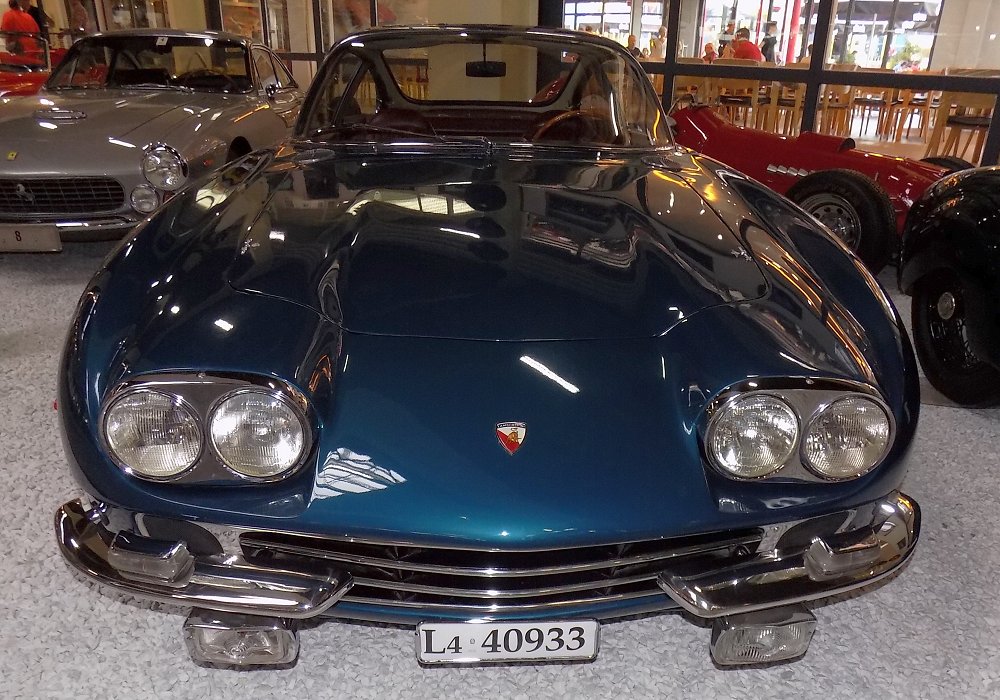Description
The Lamborghini 350/400 GT marked the decisive first chapter in Lamborghini’s rise from a newcomer in the automotive world to a true icon of Italian performance and design. Built between 1964 and 1968, these two closely related models were the company’s first production grand tourers—cars that combined technical excellence, refinement, and high-speed capability in a way few rivals could match. Together, they defined the essence of Lamborghini’s early philosophy: blending racing-grade engineering with elegant craftsmanship and a focus on effortless power rather than raw aggression.
The story began with the Lamborghini 350 GT, launched in 1964 as the production evolution of the 350 GTV prototype shown the previous year. Ferruccio Lamborghini’s goal was clear: to build a car that would rival Ferrari’s best in performance but surpass it in comfort, usability, and quality. To achieve this, he brought together some of the greatest engineering talents in Italy—Giotto Bizzarrini, who designed the engine; Gian Paolo Dallara, who developed the chassis; and Bob Wallace, who honed the car’s dynamics. The result was a car that stunned the industry with its sophistication and maturity.
At its heart lay Bizzarrini’s masterpiece: a 3.5-litre all-aluminium V12 engine, displacing 3464 cc and producing around 280 horsepower at 6,500 rpm. It featured four overhead camshafts, six twin-choke Weber 40 DCOE carburetors, and a dry sump lubrication system—an engineering specification more typical of a racing car than a road-going GT. The engine was mated to a five-speed ZF manual gearbox driving the rear wheels through a Salisbury limited-slip differential. The car could accelerate from 0 to 100 km/h (62 mph) in under seven seconds and reach a top speed of 155 mph (250 km/h).
The chassis, designed by Dallara, was a marvel of rigidity and balance. Built from steel tubing, it featured fully independent suspension all around—unequal-length double wishbones, coil springs, and telescopic dampers—along with Girling disc brakes on all four wheels. This setup gave the 350 GT a remarkable blend of composure and agility, offering both grand touring comfort and precise control through high-speed corners. The steering was light and accurate, the braking strong, and the ride smooth, making the car as comfortable on the autostrada as it was thrilling on a mountain road.
The bodywork, created by Carrozzeria Touring of Milan, was constructed using Touring’s patented “Superleggera” technique—lightweight aluminium panels over a lattice of thin steel tubes. The design was elegant and understated, with long, flowing lines, a gently curved roofline, and a proportionately long bonnet that gave it a sense of poised power. Unlike Ferrari’s more dramatic styling of the era, the Lamborghini 350 GT was graceful and refined—its form dictated by aerodynamics and proportion rather than ornamentation.
Inside, the 350 GT exuded quiet sophistication. The cabin was trimmed in hand-stitched leather with polished wood or aluminium dashboard panels, featuring Jaeger instruments and a classic Nardi steering wheel. The seats were deeply contoured for comfort, and the driving position was carefully engineered to suit long-distance touring. Unlike many Italian exotics of the time, visibility was excellent, and the car’s refinement made it genuinely practical for everyday use.
In 1966, Lamborghini introduced the 400 GT, an evolution of the original 350. The new car featured an enlarged 3929 cc version of the V12 engine, now producing between 320 and 325 horsepower. This power increase gave the 400 GT stronger midrange torque and smoother delivery, along with a higher top speed—close to 160 mph (257 km/h). The gearbox was replaced by Lamborghini’s own in-house five-speed unit, which proved quieter and easier to operate than the ZF transmission used previously. The suspension and braking systems were refined, further improving ride comfort and handling precision.
The first 400 GTs—known as the 400 GT “Interim”—were mechanically upgraded versions of the 350 GT with minor cosmetic changes. Soon after came the 400 GT 2+2, which featured a slightly longer and taller body to accommodate two small rear seats. The design, still by Touring, preserved the elegant proportions of the original but added a bit more practicality for long-distance touring. Despite the additional space, performance remained exceptional, and the car’s refinement was unmatched among its contemporaries.
Driving the 350 or 400 GT was an experience defined by smoothness and precision. The V12 was turbine-like in its delivery, revving freely to high speeds with no harshness or vibration. The combination of light steering, well-balanced suspension, and exceptional engine response made the car feel nimble and controlled. Reviewers of the time were astonished by the car’s composure—one described it as “a car that seems to shrink around the driver as speed increases.” It was a machine that could cover great distances at speed with absolute serenity, perfectly in keeping with Ferruccio Lamborghini’s vision of a true grand tourer.
The craftsmanship of these early Lamborghinis was exceptional. Each car was hand-built at the Sant’Agata factory with meticulous attention to detail. The paintwork, trim, and assembly quality rivaled that of the finest luxury marques, while the mechanical components were engineered for longevity. Ferruccio Lamborghini’s insistence on reliability—he famously wanted his cars to be as dependable as his tractors—meant that the 350 and 400 GTs were among the most robust exotics of their era.
When production ended in 1968, only about 120 examples of the 350 GT and roughly 247 of the 400 GT 2+2 had been built. Their rarity, coupled with their historical importance as Lamborghini’s first true road cars, makes them highly sought after by collectors today. They are celebrated not only for their beauty but for their mechanical integrity and the way they capture the optimism and artistry of 1960s Italian engineering.
The Lamborghini 350/400 GT pair remain foundational models in the company’s history—the cars that proved Lamborghini could compete with the best and win. They set the tone for everything that followed, from the Miura to the Aventador, establishing the V12 engine as the heart and soul of the brand. More than sixty years later, their combination of elegance, power, and sophistication still defines what a grand touring Lamborghini should be: fast, effortless, and unforgettable.


